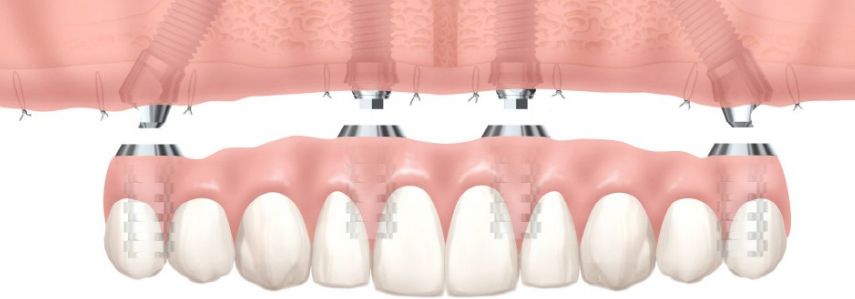Toronto Bridge is the name of a fixed prosthesis useful to replace the teeth of an entire dental arch; it is in fact a complete prosthesis with flange (or if you prefer fake gingiva), it can replace up to 12 teeth per arch, fixed through abutments (in jargon called abutments) to titanium dental implants thanks to the implantology technique immediate loading or, in more traditional dentistry, through a delayed loading implantology.
Why is it called Toronto Bridge?
The Toronto Bridge prosthesis takes its name from the Canadian city of Toronto where this new technique was presented in 1982, during the World Congress of Dentistry, as a result of the dental research of the Swedish implantology school of which the greatest exponent is Dr. Branemark.
From the 1980s to today there have been continuous evolutions and innovative research that have improved the efficiency and practicality of the Toronto Bridge prosthesis.
Which patient is suitable for Toronto Bridge?
In general, all patients with good bone can undergo surgery for the application of a fixed Toronto Bridge prosthesis. Its main feature is that of having a reduced number of implants compared to the number of teeth to be replaced, generally 4 (all on four).
The application times are reduced and the application of the immediate load All on 4 makes it possible to safely exit the clinic after the dental session without fear of detachment of the prosthesis.
The Toronto bridge is not always the best solution and is not recommended for patients with particularly high gums.
In any case, the implantologist will evaluate whether a particular patient is suitable for a Toronto prosthesis.
The Toronto Bridge prosthesis is one of the best solutions to remedy the mobile denture, because being anchored to the osseointegrated implants, the patient will have no sensation of mobility, regaining safety and confidence in every aspect of his daily life.
What are the application phases of a Toronto Bridge All on 4 prosthesis?
 The first phase, common to any implantology intervention, is a planning visit in which the Fingerprints and assessed the patient’s suitability for a particular technique.
The first phase, common to any implantology intervention, is a planning visit in which the Fingerprints and assessed the patient’s suitability for a particular technique.
Subsequently, the insertion of the 4 implants that will be fixed between the mandibular foramina in the inner part will be planned to avoid any damage to the mandibular nerve that could cause the temporary or permanent loss of sensitivity of the lower lip.
Once the implants are inserted it is possible have fixed teeth within 24 hours, thanks to the immediate load.
What characterizes the Toronto Bridge prosthesis is the presence of a flange (fake gum) that has two different functions: the first is to support the lack or thinning of the maxillary bone which, after a long period from the fall of the teeth tends to reabsorbed; the second is to cover the implants, an aesthetic function therefore, which also avoids the effect of long teeth. The flange is positioned beyond the smile line, so it is almost impossible to notice where the prosthetic gum ends and the real one begins.
However, the presence of the flange represents one of the disadvantages of the Toronto Bridge prosthesis, because below it it is easy for an accumulation of food residues to form, therefore appropriate oral hygiene is constantly monitored by your dentist.
















